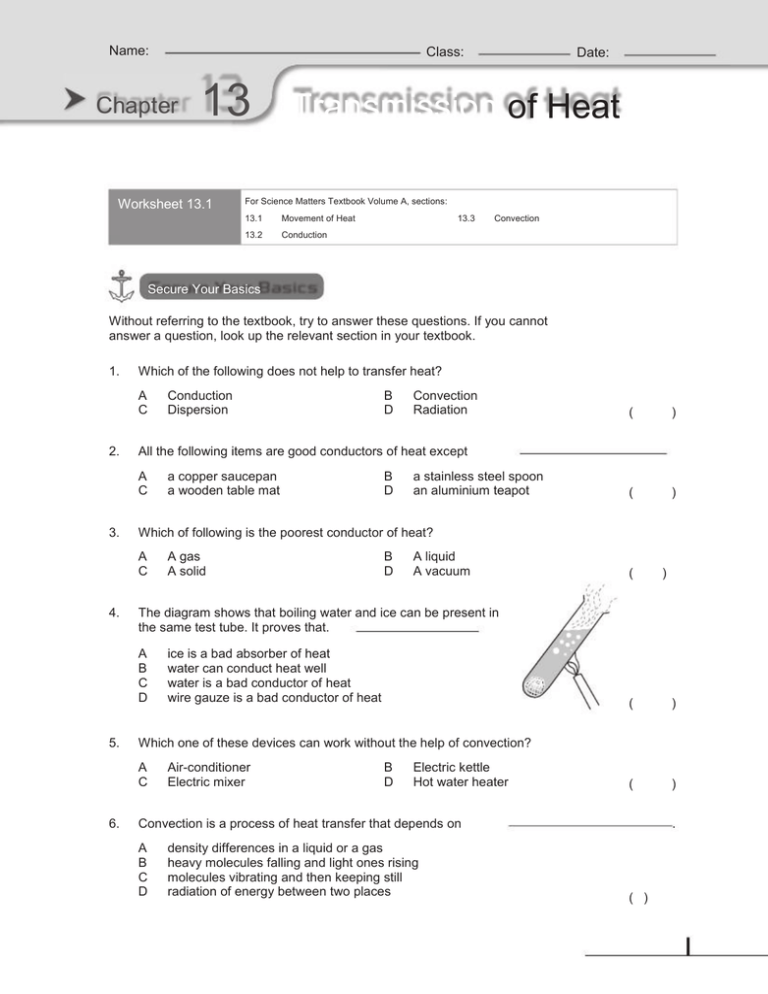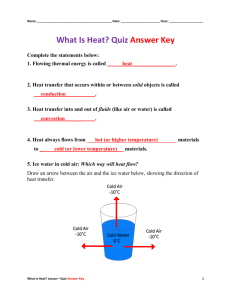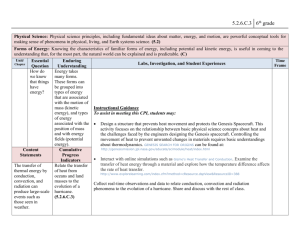13 Transmission of Heat Chapter
advertisement

Name: Class: Chapter 13 Worksheet 13.1 Date: Transmission of Heat For Science Matters Textbook Volume A, sections: 13.1 Movement of Heat 13.2 Conduction 13.3 Convection Secure Your Basics Without referring to the textbook, try to answer these questions. If you cannot answer a question, look up the relevant section in your textbook. 1. Which of the following does not help to transfer heat? A C 2. ) a copper saucepan a wooden table mat B D a stainless steel spoon an aluminium teapot ( ) A gas A solid B D A liquid A vacuum ( ) ice is a bad absorber of heat water can conduct heat well water is a bad conductor of heat wire gauze is a bad conductor of heat ( ) ( ) Which one of these devices can work without the help of convection? A C 6. ( The diagram shows that boiling water and ice can be present in the same test tube. It proves that. A B C D 5. Convection Radiation Which of following is the poorest conductor of heat? A C 4. B D All the following items are good conductors of heat except A C 3. Conduction Dispersion Air-conditioner Electric mixer B D Electric kettle Hot water heater Convection is a process of heat transfer that depends on A B C D density differences in a liquid or a gas heavy molecules falling and light ones rising molecules vibrating and then keeping still radiation of energy between two places . ( ) 7. Which of the following diagrams best shows the direction of convection currents when water is heated in a beaker? A B C D ( ) 8. Below is a photo of an air-conditioner. Explain why an air conditioner is placed high up on the wall. 9. Below is a diagram of an electric kettle. a) Which parts of the electric kettle are made of good insulators of heat? Why are they made of such materials? b) Explain why the heating element is located at the bottom of the kettle. Sketch the movement of convection current to help your explanation. 10. Below is a photo of a refrigerator. freezer Explain why the freezer compartment is often located at the top of a refrigerator. Map It Out Complete the graphic organiser that follows the question below. How does the land breeze phenomenon occur? At night, the sea is than the land. Hot air on the sea Cooler air from . blows towards . Challenge Yourself • 10 min • Attempt the following questions within the time allocated. 1. During hot sunny days, in the coastal regions, a breeze blows from the sea towards the land. This is because. A B C D 2. the sea is hotter than the land the land is hotter than the sea the sea has a higher density the land gives out heat more quickly ( B ) The sensation of cold depends on the fact that heat is leaving the body through the skin. Anything that gives heat to the body feels hot, and anything that takes away heat from the body feels cold. Explain then, why a carpet feels warmer to your feet than a marble floor, when both are at the same room temperature. . 3. In the event of a fire, it is safest to crawl near the floor. How does your knowledge of heat transfer help to explain this? 124 Transmission of Heat 2007© 2008 Marshall Cavendish International (Singapore) Pte Ltd Name: Class: Worksheet 13.2 Date: For Science Matters Textbook Volume A, section: 13.4 Radiation Secure Your Basics Without referring to the textbook, try to answer these questions. If you cannot answer a question, look up the relevant section in your textbook. 1. Which surface is the best radiator of heat? A C 2. B D Rough, dull and white Smooth, white and silvery conducted radiated B D ( ) away into On a cloudless night, the earth is cold because its heat is space. A C 3. Rough, dull and black Smooth, shiny and black convected transported ( ) Which of the following explains why the shaggy fur of a polar bear helps to keep it warm? A B C D Air trapped in the fur cannot move anywhere. Air trapped in the fur is a bad conductor. White is a bad radiator of heat. All of the above. ( ) 4. The diagrams below show four cups of the same size and mass that are made of different materials and design. If the same amount of coffee at the same temperature was poured into each of them, which cup would keep the coffee hot the longest? A B C D plastic cover stainless steel porcelain plastic plastic () 5. Which of the following will best absorb the sun’s rays? A C Clear window glass Shiny metal tray B D Dark animal fur White writing paper ( ) 6. How does heat travel through a vacuum? A C 7. By conduction and convection By radiation and conduction B D By conduction only By radiation only () If a black tin can is left out in the sun for a few hours, it will reach a steady temperature. .This is because it can A conduct heat away to the surface it rests on B heat up the air around it, which then rises C radiate a lot of heat away because it is a hot object D do all of the above, so the total heat loss is equal to the total heat gain from the sun 8. Two identical glass beakers are half-filled with equal volumes of water. One is wrapped in shiny aluminium foil and the other is wrapped in black art paper. Both are left out in the sun. After an hour,. A B C D 9. ( ) both of them arrive at the same higher temperature both radiated heat and are cooler than before the black container is warmer than the shiny container the shiny container is warmer than the black container Using what you have learnt about the transmission of heat, explain the following observations. a) An aluminium pan has a wooden handle. b) Chocolates are wrapped in silvery foils. © Two thin blankets are warmer than one thick blanket. d) Fanning your face at a football match will keep you cool. ( ) 10. If you put one hand in ice water and another in hot water, then both hands in tap water, what do you expect to feel? Why? . 11. You feel hot when you sit under a light bulb that is turned on. Explain how heat travels from the light bulb to you. Would holding a sheet of plain glass between you and the bulb make you feel cooler? Map It Out Complete the graphic organiser that follows the question below. Compare and contrast the three methods of heat transfer. Conduction Convection Transfer of heat from a region of of temperature, i.e. from a movement of the medium matter Radiation temperature to a region of to a region. movement of the medium any medium at all Is carried by Is independent of matter matter Challenge Yourself • 20 min • Attempt the following questions within the time allocated. 1. Glass has a strange property. It is transparent to heat rays from the sun, which is at 6,000 °C, but is opaque to the heat rays from cooler objects that are less than a few hundred degrees Celsius in temperature. Explain why a greenhouse (a glass house for plants) helps keep plants from freezing in icy weather during winter. 2. This diagram below shows a solar heater. Water travels continuously around the copper pipe. The slanted part of the copper pipe is on the roof of a building. It is put in a box with a glass cover. water tank solar energy glass cover black surface shiny surface insulation hot water tap water copper pipe Front view a) Explain the following: i) The part of the pipe in the sun is blackened on the side that faces the sun. ii) The pipe is silvered on the side away from the sun. iii) The box has a glass cover. iv) Styrofoam is used to cover the part of the pipe away from the sun. b) As the water absorbs the sun’s rays, it moves along the pipe. Draw an arrow in the slanted pipe to show the direction water would move. c) The hot water in the pipes gathers in the zig-zag portion within the water tank. How does heat get transferred to the water in the water tank? d) What happens when the water has given its heat to the water in the water tank? e) Why do we call this system a self-pumping system? f) What happens on cold nights? Do you think the system needs a pump after all? Get It Right In relation to the various ways in which heat is transferred, explain the function of each part of the vacuum flask shown in the diagram below. cap The stopper is made of plastic or cork. These cork materials heat within the flask. It also prevents heat lost The double-walled vessel has a vacuum between the walls. This prevents heat by and . lost by and . The walls are also silvered on the vacuum side. This minimises heat lost by . hot water vacuum silvered glass walls The ceramic base minimises heat lost by conduction . Analyse each part of the flask and how it helps minimising heat transfer from the hot water. Recall the characteristics of each method of heat transfer. Refer to the Science Matters Textbook Volume A, chapter 13 on Transmission of Heat.



![Applied Heat Transfer [Opens in New Window]](http://s3.studylib.net/store/data/008526779_1-b12564ed87263f3384d65f395321d919-300x300.png)

